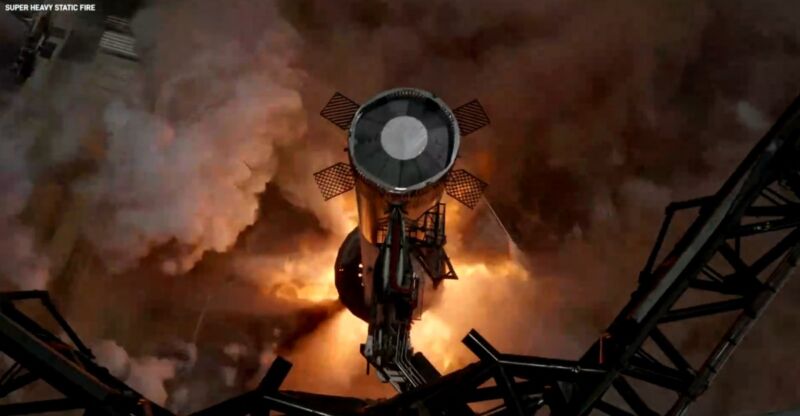
SpaceX conducted a second hot fire test of its Super Heavy booster on Friday afternoon, likely taking a key step toward the next launch of its massive new rocket.
A few minutes after the test firing, SpaceX founder Elon Musk characterized it as "successful" on the social media network formerly known as Twitter. SpaceX later confirmed that all 33 Raptor engines ignited during the test and that all but two ran for the full six-second duration.
This Super Heavy booster, the largest and most powerful rocket to ever fly, serves as the first stage of SpaceX's mega-rocket, which pushes the Starship upper stage into orbit.
The first stage in action on Friday—dubbed Booster 9, as it is the ninth to be built as part of SpaceX's iterative design methodology—underwent its first static fire test on August 6. That hot fire test ended prematurely, after 2.74 seconds. Moreover, four of the rocket's 33 main Raptor engines either did not ignite or shut down prematurely.
Getting systems ready to go
After this test in early August, the first stage rolled back to the production site, where it was outfitted with a "hot staging ring." This interstage sits atop the first stage and below the Starship upper stage. This new piece of hardware is intended to facilitate "hot staging," a difficult maneuver a couple of minutes into the flight at stage separation, in which the Starship upper-stage engines ignite before the Super Heavy first stage has completed its burn.
Booster 9 rolled a few kilometers back to the launch site this week ahead of Friday's static fire test. If additional data reviews verify this performance, it appears likely that SpaceX has completed the last major hardware test needed before a second flight of the Starship launch system. The Starship upper stage expected to fly on this booster, Ship 25, has previously completed a successful static fire test.
Additionally, the rocket's ground systems appear ready. This was a problem during the rocket's unsuccessful debut test flight in April when the lack of a sound suppression system led to significant damage, including the rupture of concrete chunks from the launch pad that rained down debris for miles around the Starbase location in South Texas. About four weeks ago, SpaceX successfully tested a new water deluge and flame deflector installed beneath the Starship launch mount.
A static fire test like the one completed Friday is typically the final rehearsal for a rocket before it takes flight. The ground systems and propellant handling are all operated like a normal launch, following test-like-you-fly procedures. It's an opportunity to ensure that the rocket and ground systems perform as intended.
Still have some paperwork to do
Given the apparent success of the test, the final significant hurdle standing between SpaceX and the second test flight of the Starship rocket is regulatory. The company must receive a launch license from the Federal Aviation Administration, which has been reviewing a "mishap investigation report" submitted by SpaceX following the April test flight.
After accepting or modifying this report, the Federal Aviation Administration and SpaceX will identify corrective actions that the company must make ahead of its second test flight to ensure the safety of people, property, and wildlife near the South Texas launch site, which is surrounded by wetlands and the Gulf of Mexico.
SpaceX has not set a public launch target yet for Starship, and sources indicated it has not yet received any clear indications from the Federal Aviation Administration about when a launch license might be forthcoming. However, it seems reasonable to conclude that the second Starship launch could take place as soon as two or three weeks from now. Further delays are always possible and, indeed, probable.


3175x175(CURRENT).thumb.jpg.b05acc060982b36f5891ba728e6d953c.jpg)

Recommended Comments
There are no comments to display.
Join the conversation
You can post now and register later. If you have an account, sign in now to post with your account.
Note: Your post will require moderator approval before it will be visible.